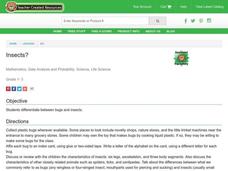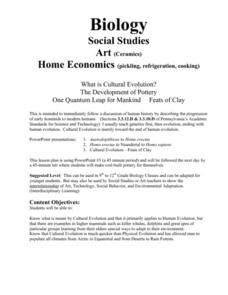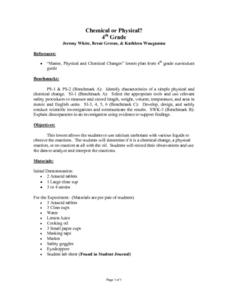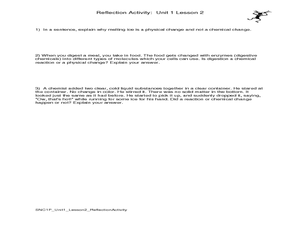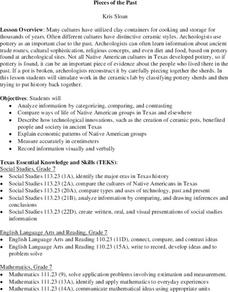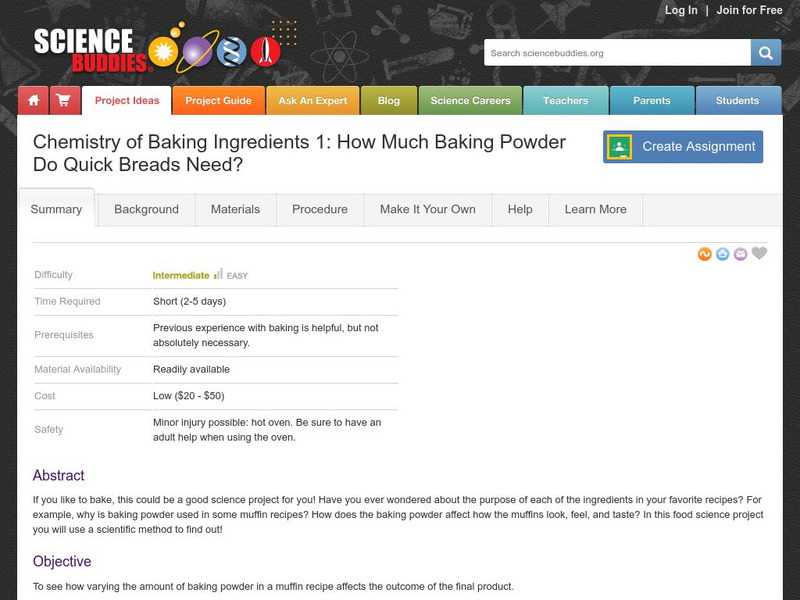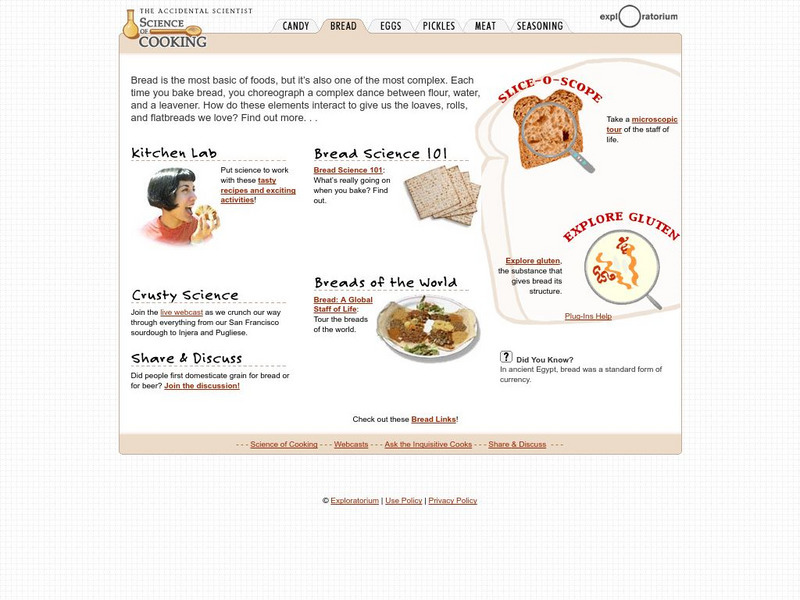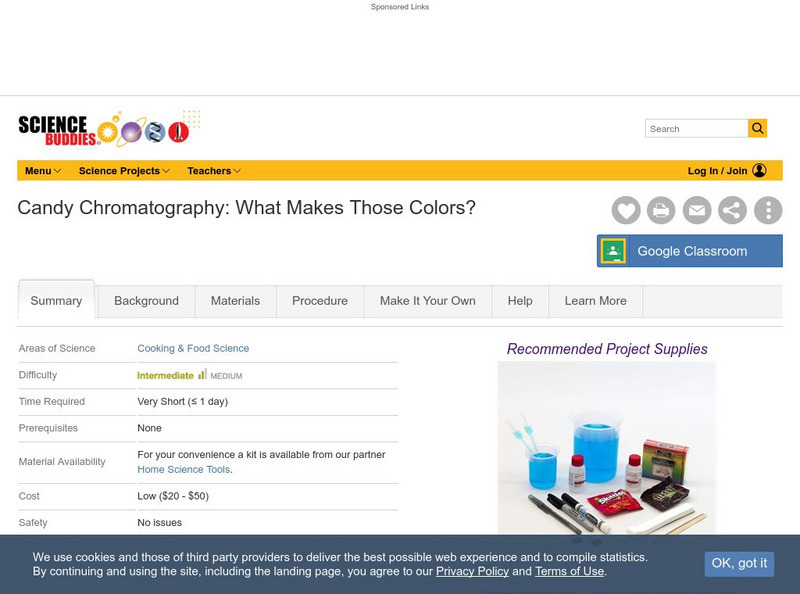Curated OER
Magma Flow
Students explore the flow of magma. They observe the effect of silica and heat on lava flow through a model using everyday items. in addition, they complete analysis questions.
Curated OER
Recipe Formats - Level II
A recipe, no matter its format, gives ingredients and instructions for a specific food so that the food item tastes the same every time. See Preface Materials:
Curated OER
Classroom Rules - Level I
Food and Science200128-Standard 20.0128-01 Students will learn the meaning of food science and management for the classroom and laboratory.
Curated OER
Fun With Food
Students participate in hands-on scientific experiments relying solely on household kitchen materials.
Curated OER
Oil Spills
Third graders examine the San Francisco oil spill and the effects it has had. In this investigative lesson plan students view a demonstration on oil clean up and how it works. They see how wildlife is rehabilitated, how the...
Curated OER
Welcome Bags
Students identify ways to make new students feel welcome. In this new students lesson, students work with school guidance counselors to identify ways to welcome new students to their school. Students create welcome bags for the new...
Curated OER
Basic Nutrition (Nutri/Food)
Students analyze the nutrition found in a food and compare it to the nutrition found in similar food. They compare the nutrition of different products and complete the student worksheet Pyramid Pizzazz. This can be done at the beginning...
Curated OER
Lesson Six
Students examine the ocean and its vast resources. In this oceans instructional activity students complete a "seaweed candy" activity then eat their creation.
Curated OER
Insects?
Students classify animals. In this insects and bugs lesson, students discuss the characteristics of insects and other closely related animals such as spiders, ticks and centipedes. Students talk about the differences between insects and...
Curated OER
Making soap you can use
Those textbook experiments are no good. Using this simple method you can make a real bar of soap. It's
Curated OER
What is Cultural Evolution?
Students comprehend what is meant by Cultural Evolution and that it primarily applies at Human Evolution, but that there are examples in higher mammals such as a killer whales, dolphins and great apes of particular groups by exploring...
Curated OER
Chemical or Physical?
Fourth graders make observations of the reactions that happens between calcium carbonate and various liquids. During the experiment the students determine if there is a chemical change, a physical reaction, or no reaction when they mix...
Curated OER
Eggs, Baked Eggs
Students explore eggs including their structure, sizes, grades, nutritional value, functions in recipes, preparation techniques, and storage guidelines.
Curated OER
Physical and Chemical Changes
Learners differentiate physical and chemical changes. In this chemistry lesson, students identify five indicators that a chemical change took place. They complete a reflection journal at the end of the activity.
Curated OER
Vocational: Kitchen Appliance Care and Safety
Learners discover how to use, operate, and clean stoves and refrigerators. Using the appliance manuals, they examine self-defrosting and frost-free refrigerators as well as manual clean, self clean, and continuous clean stoves. The...
Curated OER
Pieces of the Past
Seventh graders compare and contrast the way of life of Native Americans in Texas and around the country. As a class, they brainstorm about the uses of pottery today and use broken pieces of pottery to create an artifact. In groups,...
Discovery Education
Discovery Education: 3 M Young Scientist Lab: Disappearing Glass
Glass objects seem to disappear when placed in cooking oil.
PBS
Pbs Kids: Lunch Lab: Games: Fizzy's Food Truck
Your job is to run Fizzy's Food Truck, making burgers and keeping the customers happy, but do it fast!
Science Buddies
Science Buddies: How Much Baking Powder Do Quick Breads Need?
If you like to bake, this could be a good project for you. There is a purpose for each of the ingredients in your recipes, but not everyone is always aware of what that purpose may be. Though this lab takes multiple days, you will...
Science Buddies
Science Buddies: Determining Iodide Content of Salt
In this week long "kitchen chemistry" project you will use chemicals from the supermarket to test for the presence of iodine and iodide in salt. These are common micronutrients added to some preparations of table salt. A materials list,...
Massachusetts Institute of Technology
Mit: Open Course Ware: Courses: Kitchen Chemistry
College-level online course focusing on kitchen chemistry. Course explores the application of chemistry in recipes and cooking. Course features include links to readings, lecture notes, and a wealth of related links.
Exploratorium
Exploratorium: Science of Cooking: Bread Science and Facts
Find out the science behind making bread. This site from Exploratorium turns your kitchen into a lab and you can do much more than bake bread. Do experiments with yeast, and find out what is so exciting about gluten.
Science Buddies
Science Buddies: Candy Chromatography: What Makes Those Colors?
One of the characteristics that makes M&Ms so popular is dye that colors the hard shell, and of course the chocolate. But, many are unaware of what dyes are used to make those colors. This day long lab uses paper chromatography to...
Royal Society of Chemistry
Royal Society of Chemistry: Kitchen Chemistry
A scientific approach to kitchen skills takes a look at the chemistry involved in preparing the food we eat.








